How the Autry’s Resources Center marks a new way of managing Indigenous collections
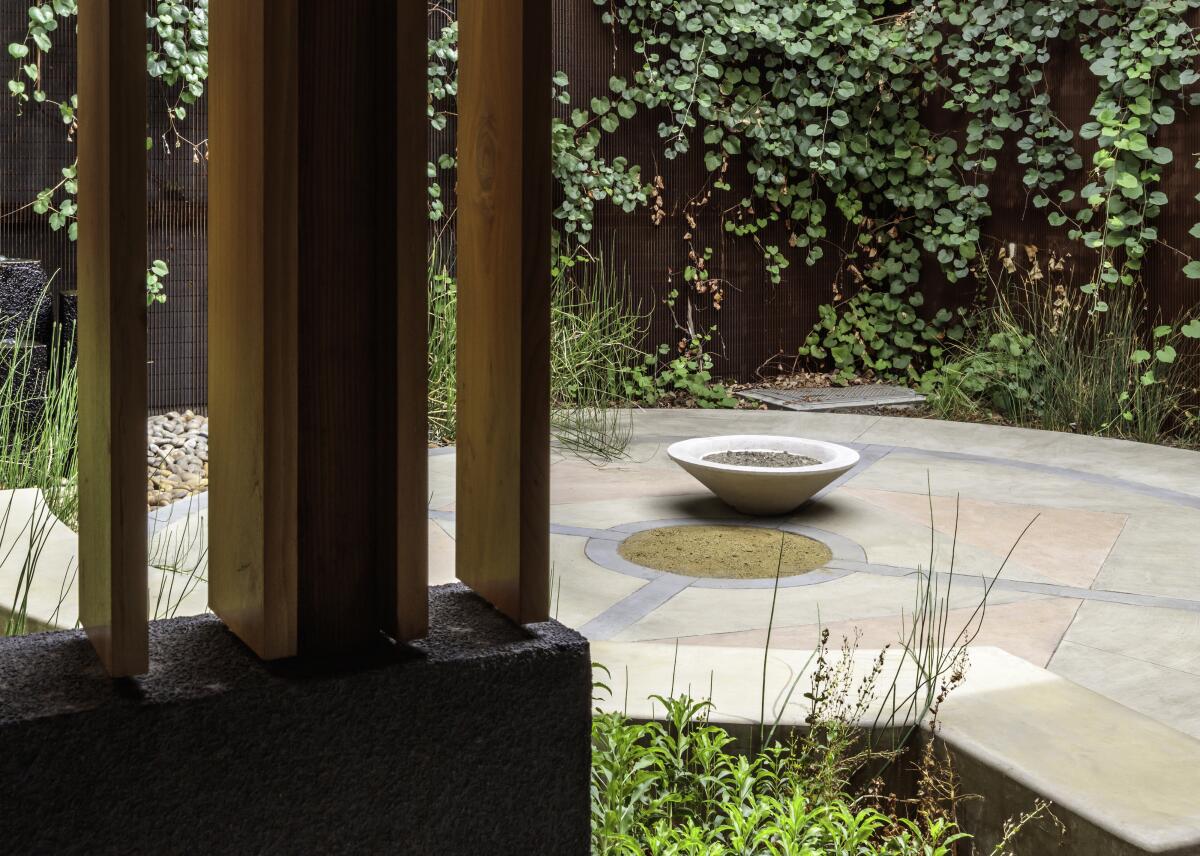
- Share via
It’s Labor Day weekend amid our Hot Labor Summer, a fine time to honor a worker with fair pay. I’m Carolina A. Miranda, art and design columnist for the Los Angeles Times and I’m here with baroque sandwiches and essential arts news:
The changing shape of museums
It was an epic undertaking. Last November, the Autry Museum of the American West relocated hundreds of thousands of objects from the Southwest Museum of the American Indian (with which it had merged in 2003) to its new Resources Center in Burbank. But the center — which occupies a sequence of refurbished industrial buildings on South Victory Boulevard — is much more than simply a storage or research space.
It contains a small garden where members of area Indigenous communities can employ artifacts from the museum’s collection in ritual ceremonies. Considered living objects, these artifacts need to be used, says Joe Horse Capture, the Autry’s vice president of Native collections. “They need light, they need to go outside and need to breathe.”
I thought a lot about this lovely little space as I walked through the cavernous new wing of the American Museum of Natural History in New York City in June. Designed by Studio Gang, the Chicago-based architecture firm founded by Jeanne Gang, the Gilder Center, as the new wing is called, looks like a literal cave.
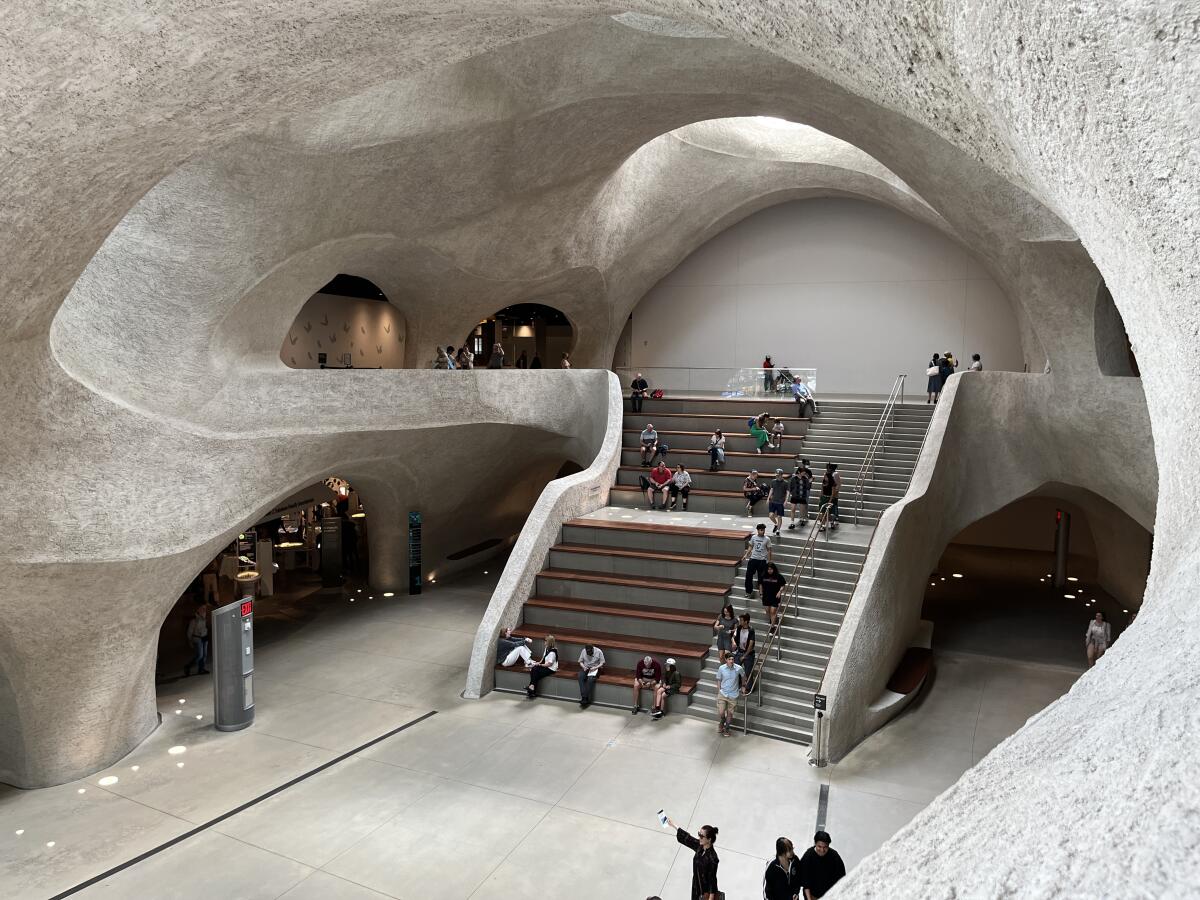
This week, I wrote about how Studio Gang’s design reframes the way natural history museums present their collections — a category of institution with a very fraught history. (The short of it: natural history museums and colonial exploits go hand-in-hand.)
That was something that made me think about how the evolving missions of museums are embedded in their architecture — which takes me right back to the Autry’s Burbank space.
The relationship between museums and Indigenous people has historically been, to put it mildly, difficult. (Pillage and warehousing the remains of ancestors will do that.) What’s unique about the Resources Center is that it takes items that were once out of public reach — handled only by preparators and generally seen only in glass cases — and puts them, quite literally, back in the hands of the cultures that produced them.
“Seeing Native material in a museum is inherently a false experience,” the museum’s former director, Rick West, a citizen of the Cheyenne and Arapaho Tribes, told me in a 2021 interview. “We never put things on walls. Every object you see is associated with life and living in a Native community.”
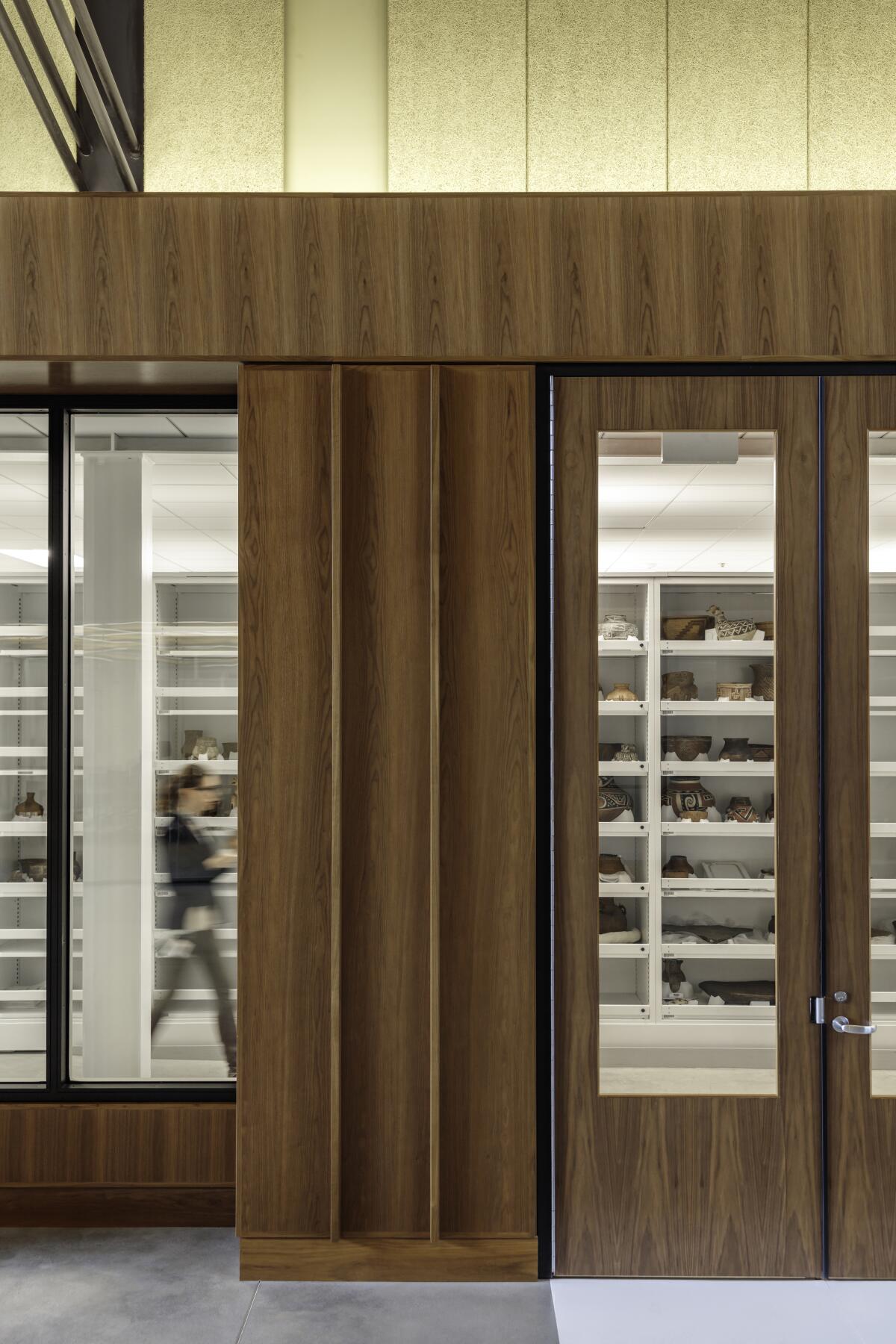
The Resources Center provides a well-designed, physical space in which a museum can begin to engage Native communities in a more constructive way. “This is a direction in which museums are going or should be going,” says Horse Capture, a citizen of the A’aninin Tribe of Montana. “As museums, as stewards of these collections, we need to provide Native communities a place to engage their culture.”
The ceremonial area, therefore, may be small, but it is very significant. (Though it’s not the first such space: The Smithsonian’s National Museum of the American Indian in Washington, where West was also director, has an off-site resources center, completed in 1998, that also includes dedicated ceremonial space.)
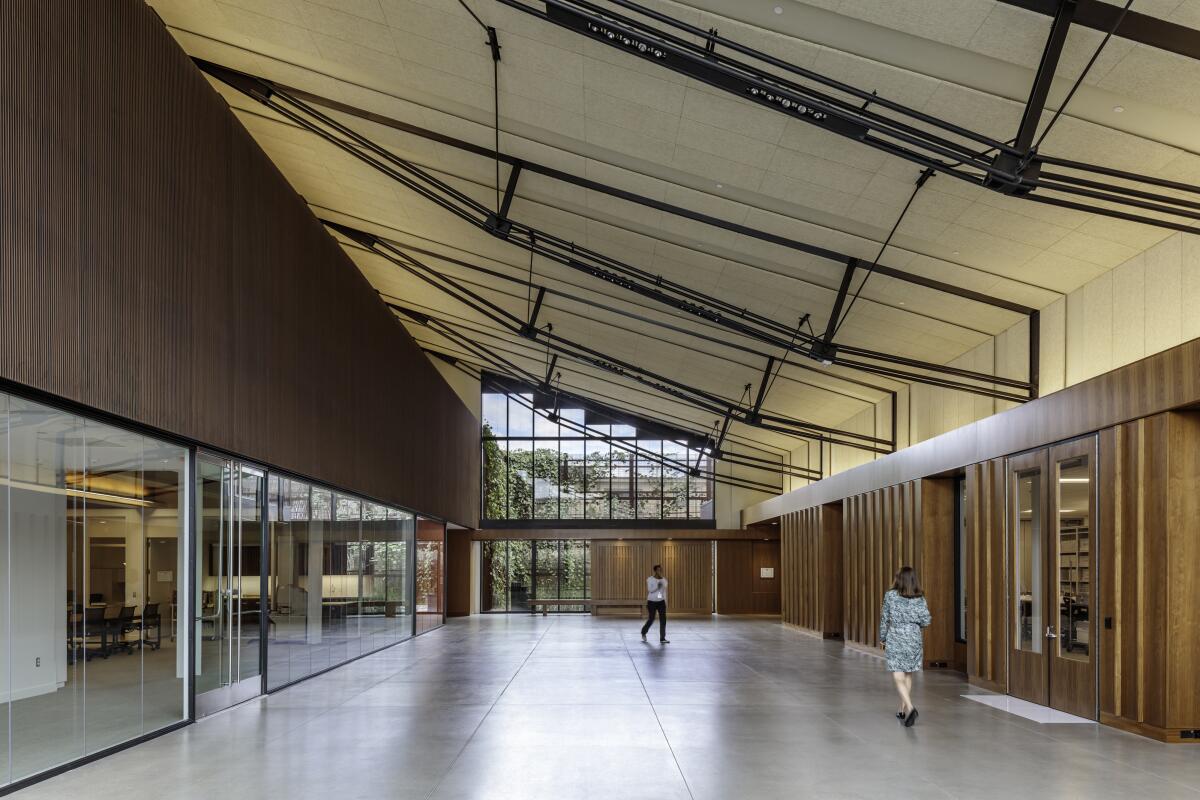
The Autry’s Resources Center, completed last year, is skillfully stitched together out of four industrial and light industrial buildings that had been abandoned for years. Designed by North Hollywood firm Chu-Gooding Architecture, the 106,000-square-foot complex features plenty of storage, but also a library, reading room, tribal gathering areas and spaces for collections care. The design makes smart reuse of pre-existing structures, as well as materials the architects found on-site. This included a large, weathered metal grate recycled as a trellis for outdoor plantings, which also screens some of the mechanical systems in the lobby.
Greeting visitors to the building is an airy atrium with a sloping roof, bordered on one side by a wooden screens crafted from walnut — some of which frame collections storage. Visible at the end of the atrium is the ceremonial garden, a welcome riot of green. Sliding walnut panels can be pulled shut during ceremonies to give the garden privacy, but they remain open at other times. The vibe is warm and scholarly.
Make the most of L.A.
Get our guide to events and happenings in the SoCal arts scene. In your inbox every Monday and Friday morning.
You may occasionally receive promotional content from the Los Angeles Times.
The garden was designed by Native-owned firm Costello Kennedy Landscape Architecture, which is headquartered in Marin County and previously designed a 7,000-square-foot ethnobotanical garden for the Autry’s Griffith Park location. Like that project, the ceremonial garden at the Resources Center was designed with the input of Native people from Southern California.
The space is small — attached to the building’s southwestern flank — but the designers make the most of it with lush plantings of vines, juncus, wild strawberry and deer grass. Additional plantings along the entrance to the facility include elderberry, an endemic plant. When the berries ripen, says Horse Capture, Tongva artists arrive to harvest them.
It’s architecture that is less about top-down storytelling than engaging a community in an ongoing dialogue. And that is a model worth replicating — no matter the scale.
On and off the stage
Alexis Scheer’s “Our Dear Dead Drug Lord” has landed at the Kirk Douglas Theatre in a production that Times theater critic Charles McNulty describes as “electric” (if unsettling). The play is about a crew of Miami girls who worship the ghost of Colombian narcotrafficker Pablo Escobar. “What are these young women after?” asks McNulty. “The illicit appeal of a drug lord’s lawlessness resonates strongly with their desire to break out of systems that treat them like subjects instead of queens. But rescue from disempowerment is only one motivation. Haunting the girls are losses too painful to process.”
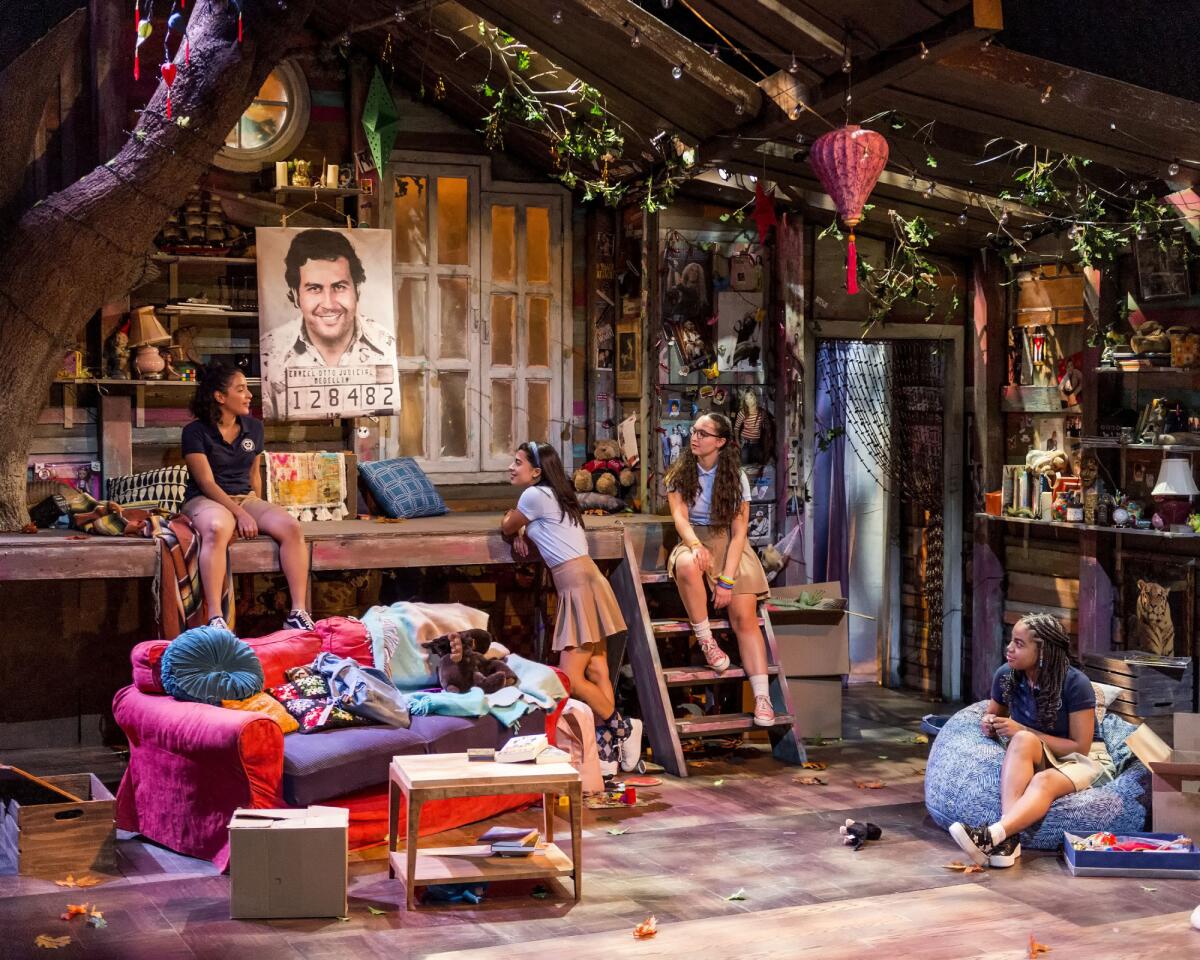
The Odyssey Theatre Company is presenting a rare production of Harold Pinter’s “A Slight Ache,” a 1959 short play that was originally written for radio. “This tightly constructed three-character play,” writes McNulty, “follows the Nobel Prize-winning playwright’s characteristic method of introducing a stranger to a domestic situation that quickly unravels as territorial instincts are unleashed to an extent that seems wildly disproportionate to the banality of the threat.”
CAP UCLA‘s new performance space, the UCLA Nimoy Theater, occupying an old, 300-seat movie theater on Westwood Boulevard, is set to open this month — kicking off with an appearance by spoken-word artist and songwriter J. Ivy. The Times’ Jessica Gelt has all the deets on this new space, and how it will give CAP UCLA more flexibility.
In and out of the galleries
No album drop in recent memory has been as hotly anticipated as the release of Donald Trump’s mugshot — along with the mugshots of his many associates — by the Fulton County Sheriff’s Office in Georgia last week. (The merch on Etsy has been quite entertaining.) Art critic Christopher Knight considers the precedents to this historic image: “Before last Friday, the most enduring mug shots in modern American culture were Andy Warhol’s ’13 Most Wanted Men,’ born as a monumental mural for crowds at the 1964 New York World’s Fair. For incongruous mug shot photography, Warhol now has some real competition in the longevity sweepstakes.”

Love this jam by my colleague Jeffrey Fleishman about a collection of photographs by John Verzi recently acquired by the Los Angeles Public Library. Haven’t heard of Verzi? He was an assiduous collector of celebrity snapshots and autographs — from an era in which it was still easy to approach someone like Charles Bronson in the parking lot of the unemployment office.
Meanwhile in Las Vegas: the Sphere, a spherical performance venue that is set to open in late September, has been commanding attention for its LED skin, which allows for the presentation of some incredible (and truly bizarre) motion graphics — from a basketball to an eyeball — at a behemoth scale. Now digital artist Refik Anadol has been commissioned to create art for its surface. “We’re used to canvas and sculpture and paintings and video, but this time, the whole building is a canvas — and not one with corners,” Anadol tells The Times’ Deborah Vankin. “It’s challenging our perceptions.”
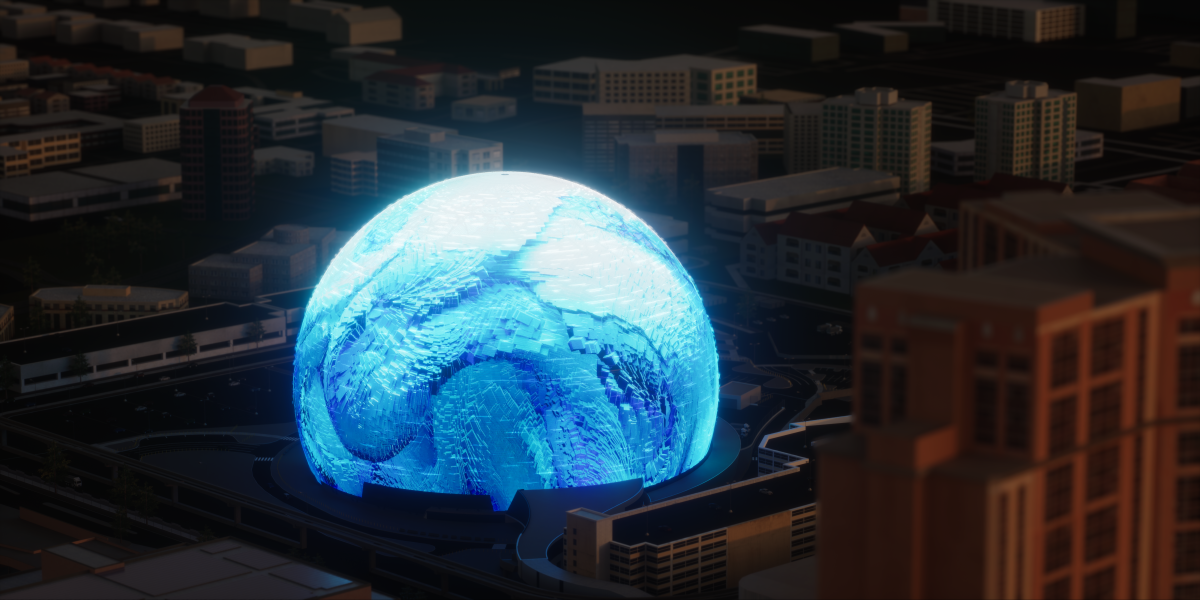
Just dance
Bob Fosse by way of Michael Jackson and the ‘70s vibe of Motown acts like the Supremes. The Times’ Steven Vargas interviews choreographer Shay Latukolan about his inspirations for the music video for Jungle’s “Back on 74,” currently tearing up TikTok. “I was thinking of my funk training,” he says of that piece, one of several he is choreographing for Jungle, “what I know as a funk dancer and the music — what it made me feel like. It’s the rhythm.”
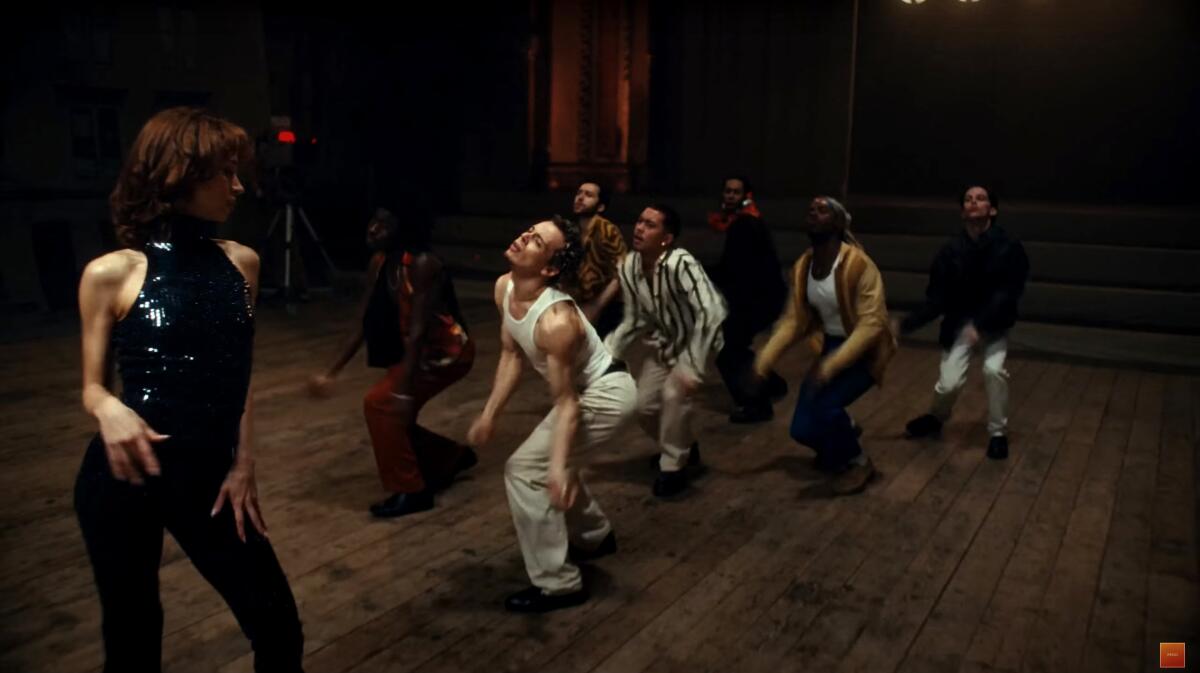
Plus, contributor Michelle Vartan on why social media is obsessed with the shuffle.
Fall Preview
It’s fall preview time — and there is plenty afoot for the season.
At the Mt. Wilson observatory, the Industry will be presenting the opera “Star Choir,” about a group of astronauts who come into contact with an alien. It is the brainchild of Industry co-director Malik Gaines and his partner, Alexandro Segade. Segade tells contributor Catherine Womack that he didn’t want to clutter the observatory with too many scenic additions. “We want to just work with it to create ambiance,” he says. “We are looking at Ridley Scott’s ‘Alien’ to get ideas about how to light a space like this.”

In anticipation of the next “Made in L.A.” biennial at the Hammer Museum (opening Oct. 1), Deborah Vankin hung with artist Vincent Enrique Hernandez, who is staging five-hour “performative” tours of the San Fernando Valley as part of the exhibition. The tour will cover everything from iconic signage and public art to important anecdotes about his neighborhood’s wayward tortoise. “This isn’t a Hollywood sightseeing tour where you’re gonna see all these things from the big screen,” he tells Vankin. “A lot of this stuff is the stuff that slips between the cracks or is under your nose.”
The Times’ arts team came together to compile a list of 30 recommends for the season, including art, theater, music, opera and lots of dance! Expect everything from a play inspired by a Toni Morrison novel to an opera drawn from the lives of Frida Kahlo and Diego Rivera.
Enjoying this newsletter? Consider subscribing to the Los Angeles Times
Your support helps us deliver the news that matters most. Become a subscriber.
Hollywood’s Egyptian Theatre, which was purchased by Netflix in 2020, is ready for its close-up. After a major renovation, the theater is set to reopen this fall — and my colleague Glenn Whipp got a sneak peek. “With the current renovation,” he writes, “Netflix has focused on taking the space back to its original appearance.” That includes removing signage that blocked the building’s dramatic forecourt and removing acoustic panels installed in the ‘90s. Here’s praying they kick off with a screening of “Cleopatra.”

I sneaked over to the Books section to profile L.A. writer Myriam Gurba, best known as the writer whose scathing review of Jeanine Cummins’ border thriller “American Dirt” turned into a reckoning about representation in publishing. But as I note in my profile, that short essay is the least interesting thing about her. The author of the taut memoir “Mean” and the upcoming “Creep” (due out next week) has many interesting things to say about the ways in which oral traditions can be captured in print and that time Juan Rulfo (of “Pedro Páramo” fame) sold her grandfather an incomplete set of encyclopedias.
You can find a list of the season’s must-reads right here. And you can find our complete Fall Preview package — featuring film, television, music and more — over here.
Essential happenings
What’s happening this weekend is Beyoncé, and Steven Vargas has the essential guide — with many other art events too.
Moves
This is good news for L.A.: the Getty Research Institute has acquired Maren Hassinger‘s archive.
The de Young Museum in San Francisco has announced the 887 participants of its annual “The de Young Open,” an open-call exhibition featuring work by Bay Area artists. Already, it has sparked a San Francisco Salon des Refusés.
Passages
Architect Norman Pfeiffer, who designed the Colburn School of Music, as well as important expansions for the Los Angeles Central Library, the Los Angeles County Museum of Art and the Griffith Observatory, has died at 82. “As an architect, Norman was able to think beyond the edges of a building to consider what a building can do for a community,” former colleague Jean Gath tells contributor Shane Reiner-Roth. “As a leader, his legacy is one of collaboration.”
The L.A. Public Library has some great images of the wing he designed as an addition to Bertram Goodhue‘s historic public library downtown.

Architect, critic and historian Jean-Louis Cohen, an expert on 20th century architecture and an authority on Le Corbusier, has died at 74. In 2003, The Times followed Cohen and a group of students around L.A. as they investigated everything from Greene and Greene to Frank Gehry.
Ronald L. Freeman, a Washington, D.C., photographer who chronicled Black life, has died at 87.
John E. Warnock, a founder of Adobe Inc. and co-inventor of the PDF (which stands for page description format), is dead at 82. I’ll be pouring one out for the inventor of a technology that allows the likes of me to quickly find something in a 500-page museum catalog with no index.
In the news
— Hartwig Fischer, director of the British Museum, said he would step down amid investigations into the theft of hundreds of items that were likely pilfered by a former staff member.
— Hundreds of works held by Douglas Chrismas’ Ace Gallery will be liquidated to repay creditors.
— An N.C. Wyeth painting acquired at a thrift store for $4, and depicting a scene out of Helen Hunt Jackson’s “Ramona,” is going up for auction.
— The art world has been chattering about Sean Tatol‘s recent essay in the Point about negative criticism.
— Artnet’s Ben Davis responds in one and two parts.
— Real Life Event That Could Have Been a Plot Written by Ayn Rand: A bunch of tech billionaires want to build a city from scratch in Northern California.
— Speaking of Ayn Rand, “Our Opinions Are Correct” devotes a recent episode to how Silicon Valley gets Rand wrong.
— A wild, Postmodern lobby designed by Kevin Roche and John Dinkeloo at 60 Wall St. in Manhattan is in danger of being gutted.
— L.A.’s Pershing Square is finally breaking ground on a long-planned revamp. Though the design is not by Agence Ter (who won a design competition for the project), but by Gruen Associates.
— I’ve really been enjoying the National Academy of Design‘s “Exquisite Corpse” podcast, especially this episode featuring a conversation between artists Rashid Johnson and Charles Gaines.
And last but not least ...
I need to know more about this absolutely excessive Portuguese sandwich called the Francesinha.
The biggest entertainment stories
Get our big stories about Hollywood, film, television, music, arts, culture and more right in your inbox as soon as they publish.
You may occasionally receive promotional content from the Los Angeles Times.




